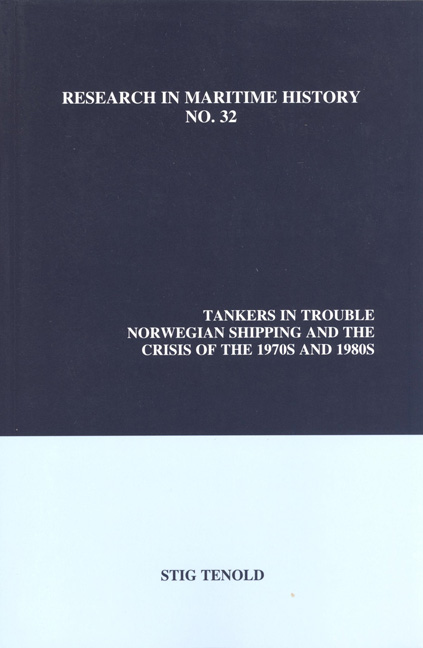Book contents
- Frontmatter
- Table of Contents
- List of Tables in the Text
- List of Illustrations
- Preface
- Chapter 1 Introduction
- Chapter 2 The Shipping Market after World War II
- Chapter 3 The Basis of the Tanker Crisis
- Chapter 4 The Contagion and Short-term Effects of the Crisis
- Chapter 5 Stage Two of the Crisis and the Long-term Changes
- Chapter 6 The Basis for the Crisis in Norwegian Shipping
- Chapter 7 Structural Transformations in Norwegian Shipping
- Chapter 8 The Fates of Four Norwegian Shipowners
- Chapter 9 Conclusion
- Appendices
- Bibliography: Select Bibliography
Chapter 1 - Introduction
- Frontmatter
- Table of Contents
- List of Tables in the Text
- List of Illustrations
- Preface
- Chapter 1 Introduction
- Chapter 2 The Shipping Market after World War II
- Chapter 3 The Basis of the Tanker Crisis
- Chapter 4 The Contagion and Short-term Effects of the Crisis
- Chapter 5 Stage Two of the Crisis and the Long-term Changes
- Chapter 6 The Basis for the Crisis in Norwegian Shipping
- Chapter 7 Structural Transformations in Norwegian Shipping
- Chapter 8 The Fates of Four Norwegian Shipowners
- Chapter 9 Conclusion
- Appendices
- Bibliography: Select Bibliography
Summary
How bad might a “worst case” scenario be? There are some examples in economic history of rapidly disappearing markets, usually in connection with conflicts, the introduction of new products or revolutionary technologies. Yet the shipping crisis of the 1970s and 1980s illustrates that even without such disruptions, sustained and rapid expansion might abruptly be replaced by decline.
In the marine sector the starting point was favourable. By 1973 the market for oil transports had grown more or less without interruption for a century. Indeed, in the previous decade annual growth in tanker transport demand had averaged almost seventeen percent. Most shipowners acted accordingly, ordering new capacity on the belief that strong growth would continue. Although a limited number of pessimists predicted lower growth rates, no one expected an absolute decline. A decade later the situation was quite different. By 1983 the demand for tanker transport had more than halved compared with the peak, and more than fifty percent of the tanker fleet was superfluous. Not even the most pessimistic observer would have predicted such a shift.
This book analyses the causes and effects of the most serious crisis in the shipping market in the twentieth century. The analysis is conducted at three progressively narrower levels. Initially, the basis for the crisis at the macro level is examined. The starting point is the tanker sector, where the problems surfaced first and were most severe. After a discussion of the effects and spread of the crisis, we move to the national level. The initial focus here is Norwegian shipping and shipowners in general. Finally, we take the analysis to an even more detailed level, using a business history perspective to focus on the strategies and fates of four individual tanker owners.
In some ways, the structural shift in the shipping market after 1973 mirrors the general development of the world economy, although the fluctuations within shipping were more pronounced. This was the case in the period before 1973, when shipping demand grew faster than world trade in general. It was also very clear after 1973: whereas most sectors of the economy suffered from lower growth rates, there was an absolute decline in demand within a number of sectors in the shipping industry.
- Type
- Chapter
- Information
- Tankers in TroubleNorwegian Shipping and the Crisis of the 1970s and 1980s, pp. 1 - 6Publisher: Liverpool University PressPrint publication year: 2006



